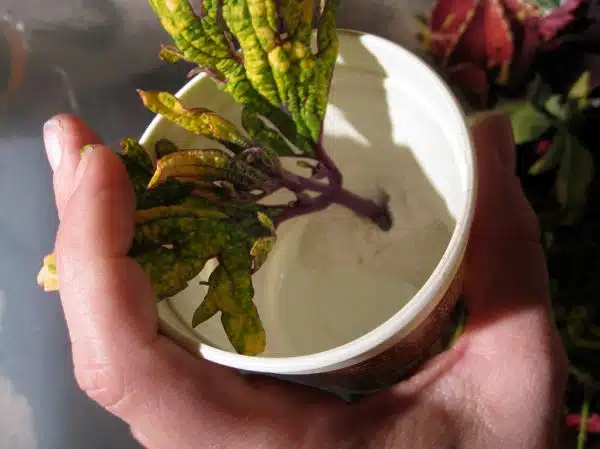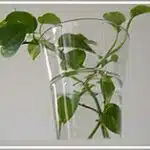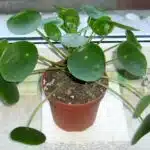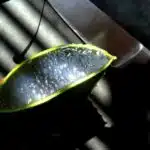As a horticulture expert, I have come across many gardeners and plant enthusiasts who struggle with propagating new plants. While there are several methods of propagation, using rooting hormone is one of the most effective ways to promote healthy root development in cuttings. Rooting hormone is a synthetic or natural substance that encourages the formation of roots on cuttings and helps them establish themselves as independent plants.
When used correctly, rooting hormone can significantly increase the success rate of propagating new plants. However, it’s essential to understand its proper application and dosage to avoid damaging your cuttings. In this article, we will explore how to use rooting hormone effectively and provide tips on how to maximize its benefits for successful propagation. Whether you’re an experienced gardener or just starting with propagation, this guide will help you achieve impressive results with rooting hormone.
Understanding Rooting Hormone And Its Benefits
Rooting hormone is a synthetic or natural compound that stimulates the growth of roots in cuttings. It is popular among horticulturists because it significantly enhances the success rate of propagation. The hormone can be applied as a powder, gel, or liquid to the stem cuttings to encourage root development.
The benefits of using rooting hormone include quicker and more robust root formation, which leads to faster plant growth and establishment. Rooting hormone also improves the chances of propagating plants that are difficult to grow from cuttings. On the other hand, drawbacks associated with rooting hormone include the cost and potential negative effects on the environment if used excessively.
Effectiveness and safety are crucial factors to consider when using rooting hormone. Some types of hormones may not work on certain plants, while others may cause harm if used incorrectly. Always follow label instructions when applying rooting hormone and wear protective gear such as gloves and eye goggles to avoid contact with skin or eyes. While rooting hormone is generally considered safe for humans and pets when used properly, it is important to store it out of reach of children and animals.
Moving forward, understanding different types of rooting hormone can help determine which one is best suited for your needs.
Types Of Rooting Hormone
Did you know that rooting hormones can increase the success rate of propagating plants by up to 95%? This is because rooting hormones stimulate cell division and growth, leading to the production of new roots. Rooting hormones come in different types, each with its benefits and disadvantages.
The two main categories of rooting hormones are natural and synthetic. Natural rooting hormones, such as honey or willow water, contain naturally occurring auxins that promote root growth. They are inexpensive and readily available. However, their effectiveness varies depending on the plant species and the concentration used. Synthetic rooting hormones, on the other hand, contain synthetic auxins that mimic those found in plants. They are more potent than natural rooting hormones and have a higher success rate when used correctly. However, they are more expensive and may be harmful if not used correctly.
Choosing the right rooting hormone for your plants depends on several factors such as plant type, age, and condition. It is essential to research the specific needs of your plant before selecting a rooting hormone. By understanding the differences between natural and synthetic options, you can determine which one is best suited for your needs. In the next section, we will discuss how to choose the right rooting hormone for your plants based on these factors.
Choosing The Right Rooting Hormone For Your Plants
Rooting hormone is a popular tool used by horticulturists to propagate and grow plants. It’s essential to choose the right type of rooting hormone based on your plant’s needs. There are three main types of rooting hormones: synthetic, natural, and organic. Synthetic hormones are made in laboratories and have a high concentration of auxins, which promote root growth. Natural hormones come from plants and contain similar ingredients as synthetic ones but in lower concentrations. Organic hormones are made from natural materials such as willow bark or honey.
When deciding on which type of rooting hormone to use, consider the plant species you’re working with and what stage of growth it’s in. Synthetic hormones work best for difficult-to-propagate plants or when you need to speed up the root formation process. However, some gardeners prefer using natural or organic alternatives due to their benefits. These include being less toxic for the environment, more sustainable, and generally cheaper.
If you’re interested in using natural alternatives to synthetic rooting hormones, there are several options available to you. Willow water is one alternative that is easy to make at home by soaking willow twigs in water overnight. Another option is using pure honey or pure aloe vera gel diluted in water as a rooting hormone substitute. These alternatives can work just as well as synthetic versions while being safer for both the environment and your health.
Choosing the right type of rooting hormone for your plant can be challenging but rewarding. By considering factors such as plant species and growth stage, you can ensure optimal results when propagating new plants. Additionally, exploring natural alternatives such as willow water or honey can lead to discovering new ways of caring for your garden while promoting sustainability and environmental protection.
Looking into when to use rooting hormone? Understanding the timing of application is crucial for successful propagation – read on!
When To Use Rooting Hormone
After choosing the right rooting hormone, the next step is to know when to apply it. Timing is crucial for the success of your plant propagation. The best time to use rooting hormone is when you are taking cuttings from a plant. Cuttings are small pieces of the plant stem that you can replant and grow into a new plant. Applying rooting hormone on these cuttings can help them develop roots faster and increase their chances of survival.
Using rooting hormone has several benefits for your plants. It promotes root growth, which improves nutrient uptake and overall health of the plant. This helps increase yield and quality of crops, making it an essential tool for farmers and gardeners alike. Rooting hormone also protects cuttings from diseases and pests that can harm them during the propagation process.
To maximize the benefits of using rooting hormone, make sure to follow instructions carefully and apply it only when necessary. Overuse may cause harm to your plants instead of helping them grow. Additionally, always choose natural or organic hormones over synthetic ones as they are safer for both plants and humans.
Transition: Now that you know when to apply rooting hormone and its benefits, let’s move on to preparing your cuttings for rooting without causing any damage.
Preparing Your Cuttings For Rooting
Cutting selection is the first step in preparing your cuttings for rooting. It is important to choose a healthy and disease-free plant from which to take cuttings. Select a branch that is at least six inches long with several nodes. Nodes are the areas on the stem where leaves grow out, and these areas are where roots will start forming.
Once you have selected your cutting, it is time to prepare it for rooting. Begin by removing all of the leaves from the bottom half of the stem. This will prevent excess moisture loss from transpiration and allow the cutting to focus its energy on root growth instead of leaf maintenance. Use a sharp blade or scissors to make a clean, angled cut just below a node on the stem.
After making your cuts, be sure to place your cuttings in water immediately. This will keep them hydrated until they can be planted in soil or another rooting medium. Do not let them sit out for too long as this can cause damage to the tissue and reduce their ability to root successfully. With proper cutting selection and preparation techniques, you can ensure that your cuttings have the best chance of developing roots quickly and successfully once you apply rooting hormone in our next section.
Applying Rooting Hormone To Your Cuttings
When it comes to propagating plants, rooting hormone is an important tool to have in your arsenal. It helps increase the chances of successful rooting and can speed up the process as well. There are several types of rooting hormones available on the market, including powders, liquids, and gels.
Powdered rooting hormone is the most common type and is often applied by dipping the cutting into the powder before planting it in soil. Liquid hormone can be applied directly to the cutting or added to water for watering. Gels are a bit thicker and stickier than liquid hormones and are often preferred for use with stem cuttings.
However, if you’re looking for a more natural approach, there are alternatives to synthetic rooting hormones available. Willow water is a popular option made by steeping willow twigs in water overnight. Other options include honey, cinnamon, and apple cider vinegar. These natural solutions not only serve as a rooting hormone but also provide additional benefits such as antibacterial properties or plant growth stimulants. By utilizing these options, you can propagate your plants with confidence while avoiding potentially harmful chemicals.
Next up, we’ll discuss dip and stick methods of applying rooting hormone to your cuttings. These techniques require a bit more precision but can lead to even higher success rates when done correctly.
Dip And Stick Methods Of Application
- The dipping method is a simple and straightforward way to apply rooting hormone to a cutting.
- The stick method involves inserting the cutting into a container of rooting hormone, which is allowed to cling to the stem.
- The concentration of rooting hormone to be used depends on the plant species and the type of cutting taken.
- In general, higher concentrations are used for hardwood cuttings, while lower concentrations are used for softwood cuttings.
- It is important to follow the label instructions carefully when applying rooting hormone, as incorrect concentrations can reduce the chances of successful root formation.
- In some cases, a combination of the two methods may be used to ensure adequate coverage of the hormone.
Dipping Method
When it comes to propagating plants, the use of rooting hormone is a common practice. Rooting hormone aids in the development of roots by providing the necessary hormones and nutrients for growth. One method of applying rooting hormone is through the dipping method.
The dipping method involves dipping the cutting directly into the rooting hormone powder or liquid before planting it. This method provides direct contact between the hormone and the cutting, which can increase success rates. However, there are common mistakes that can occur with this method. One mistake is leaving the cutting in the hormone for too long, which can lead to overexposure and damage to the plant. It is important to follow instructions carefully and only dip for the recommended time.
Success rates with the dipping method vary depending on various factors such as plant species and environmental conditions. However, when done correctly, this method can significantly increase success rates in propagating plants. Remember to handle cuttings gently and use a clean cut to maximize chances of success. By following proper techniques, you can successfully propagate your beloved plants using rooting hormone through the dipping method.
Stick Method
Another method of applying rooting hormone to plant cuttings is through the stick method. This involves inserting the cutting into a hole made in rooting hormone powder or gel before planting it in soil. The advantage of this method is that it allows for more controlled and even application of the hormone, which can increase success rates.
To use the stick method, make sure to first prepare a clean and sharp cutting. Then, dip the bottom end of the cutting into water or aloe vera gel before inserting it into the rooting hormone powder or gel. Be sure to tap off any excess powder or gel and insert the cutting into pre-made holes in soil. Water thoroughly and cover with a plastic bag or dome to maintain moisture levels.
Common mistakes that can occur with this method include using too much or too little hormone, not making deep enough holes for the cuttings, and not keeping soil moist enough during propagation. Troubleshooting tips include adjusting hormone concentration based on plant species and experimenting with different mediums such as sand or vermiculite for better results. By following proper techniques and avoiding common mistakes, you can successfully propagate plants using rooting hormone through both dipping and sticking methods of application.
Choosing A Hormone Concentration
When it comes to applying rooting hormone through dip and stick methods, one important factor to consider is the concentration of the hormone. The effectiveness of the hormone depends on its strength, which can vary based on the plant species and type of cutting being propagated. Therefore, it is crucial to choose the appropriate concentration for your specific plant in order to achieve optimal results.
Measuring effectiveness is key when determining the appropriate concentration of rooting hormone. It’s important to note that using too little hormone may not produce sufficient root development, while using too much can potentially harm or even kill the cutting. As such, it is recommended to start with a lower concentration and gradually increase as needed based on observation and success rates.
However, it’s also important to be aware of potential risks associated with using rooting hormone at higher concentrations. Some hormones contain synthetic auxins which can disrupt natural hormonal balance in plants if overused. It’s always best practice to follow instructions carefully and avoid overuse, as well as properly disposing any unused solution. By taking these precautions into account and selecting an appropriate concentration for your plant species, you can successfully propagate cuttings with rooting hormone through dip and stick methods.
Powdered And Gel Forms Of Rooting Hormone
In addition to liquid rooting hormone, there are also powdered and gel forms available on the market. The best brands of powdered rooting hormone usually contain indole-3-butyric acid (IBA) as the active ingredient. This form is particularly useful for hardwood cuttings, as it provides a higher concentration of IBA than most liquids. However, the application technique can be more difficult, as the powder needs to be evenly distributed on the cutting.
Gel forms of rooting hormone have become increasingly popular in recent years due to their ease of use. The gel typically contains a synthetic auxin like IBA or naphthalene acetic acid (NAA). The gel stays in place once applied, which makes it ideal for vertical cuttings or those that need to be planted upside down. Some of the best brands offer clear gels that allow you to easily see where you have applied the hormone.
When using either powdered or gel rooting hormone, it is important not to overuse the product. While some gardeners may think that adding extra will increase their success rate, this is not true and can actually harm the cutting. Overuse can lead to toxicity and even death of the plant tissue. It is always best to follow application instructions carefully and only use what is necessary for successful rooting.
As we have discussed, there are various forms of rooting hormone available on the market including powder and gel options. Each has its own benefits depending on your needs as a gardener, but it is essential to choose one from among the best brands available in order to ensure quality results. When using any form of rooting hormone, it’s crucial not to overdo it with application; following instructions carefully will help avoid potential harm to your plants. In our next section, we will discuss tips for avoiding overuse of rooting hormone.
Avoiding Overuse Of Rooting Hormone
Did you know that overuse of rooting hormone can have detrimental effects on the environment? According to recent studies, excess rooting hormone can contaminate soil and water sources, leading to negative impacts on plant and animal life. As horticulture enthusiasts, it is our responsibility to use this tool wisely and with care.
To avoid waste and potential harm to the environment, it is important to use rooting hormone in the proper dosage. Here are some tips to help you do so:
- Read the instructions carefully before using rooting hormone.
- Only apply the recommended amount of hormone to your cuttings.
- Avoid using more than one application of rooting hormone per cutting.
- Dispose of any excess hormone properly according to local regulations.
As a horticulture expert, I urge you to be mindful of how you use rooting hormone. By avoiding overuse and following proper dosage guidelines, we can ensure that our plants thrive without harming the environment.
Now that you understand how to use rooting hormone responsibly, let’s move on to planting your cuttings.
Planting Your Cuttings
After applying rooting hormone to your cuttings, it is time to plant them. Proper planting technique is crucial for the success of your new plants. First, choose a location that provides adequate sunlight for your chosen plant species. It is also important to ensure ideal soil conditions by amending the soil with compost or other organic matter.
Once you have chosen a suitable location and prepared the soil, it is time to plant your cuttings. Before planting, make sure each cutting has at least one set of leaves and remove any excess foliage from the stem. Using a pencil or similar object, create a hole in the soil and gently insert the cutting into the hole. After planting, water thoroughly with proper watering techniques specific to your plant species.
Proper watering and ideal soil conditions are essential for successful growth of newly rooted plants. Watering too much or too little can result in root rot or dehydration, respectively. Soil should be kept moist but not waterlogged, and drainage holes should be present in containers to prevent water buildup. By following these guidelines, you can ensure healthy growth of your newly rooted plants.
To continue caring for your newly rooted plants after planting, there are several steps you can take including monitoring moisture levels regularly and fertilizing as needed. Additionally, providing adequate light and maintaining proper temperature will promote optimal growth. By following these steps and continuing to provide attentive care, you can watch your new plants thrive and flourish in their new environment.
Caring For Your Newly Rooted Plants
After successfully planting your cuttings, the next step is to use rooting hormone. This is a crucial step that will ensure the formation of roots in your cuttings. Rooting hormones contain a synthetic version of auxin, a naturally occurring plant hormone that promotes root growth.
To use rooting hormone, first dip the base of your cutting into the hormone powder or solution. Be sure to follow the manufacturer’s instructions on how much powder to use and how long to soak the cutting for. Once your cutting has been treated with rooting hormone, plant it in well-draining soil and water it thoroughly.
It’s important to note that while rooting hormone can increase the success rate of root formation, it won’t guarantee it. Proper care and attention are still required for your cuttings to thrive. This includes maintaining proper watering frequency and ensuring they receive adequate sunlight requirements. By following these steps, you’ll be well on your way to growing healthy plants from cuttings.
As you begin caring for your newly rooted plants, keep an eye out for any issues that may arise. Some common problems include yellowing or drooping leaves, wilting stems, or fungal growth on the soil surface. In our next section, we’ll explore troubleshooting common issues that may arise when propagating plants from cuttings and how to address them effectively.
Troubleshooting Common Issues
Common mistakes can happen when using rooting hormone. One mistake is to apply too much hormone on the plant cuttings, which can result in damage or even death of the plant. Another mistake is to not properly sanitize the cutting tools before use, which can introduce diseases that may harm the plants. Lastly, some gardeners may be tempted to skip the recommended waiting time for the hormone to dry on the cuttings before planting them in soil. This mistake can cause the hormone to wash off and reduce its effectiveness.
To avoid these common mistakes, it is important to follow proper procedures when using rooting hormone. First, carefully read and follow the instructions provided by the manufacturer. Secondly, sanitize all tools and surfaces that will come into contact with your plant cuttings to prevent any diseases from infecting your plants. Lastly, do not rush through the process; give enough time for the hormone to dry on your cuttings before planting them in soil.
Even with proper care and attention, issues may still arise when using rooting hormone. A common issue is that despite applying rooting hormone correctly, there may be no visible signs of root growth after a few weeks. In this case, try adjusting environmental factors such as humidity levels or temperature around your plants to encourage root growth. Additionally, make sure you are using fresh and healthy plant material for cutting; old or diseased plant material may not grow roots well even with rooting hormones applied.
Moving forward with alternatives to rooting hormones requires understanding how their application differs from traditional methods. Rather than relying on synthetic hormones that stimulate root growth directly, natural alternatives like honey or aloe vera use natural enzymes and nutrients that indirectly help promote root development in plants. These alternatives are a great option for those who prefer organic gardening practices or want more control over what goes into their plants’ growth process.
Rooting Hormone Alternatives
If you have been experiencing difficulties with propagating your plants, rooting hormone may be the solution. This hormone is a plant growth regulator that helps stimulate root development in cuttings. To use rooting hormone, dip the cut end of the plant stem into the powdered or liquid form and then plant it in soil or water. However, some gardeners prefer natural options and homemade recipes over synthetic rooting hormones.
Natural options for rooting hormone include honey, apple cider vinegar, and willow water. Honey contains enzymes that promote root growth, while apple cider vinegar helps balance pH levels to prevent fungus and bacteria from attacking the cutting. Willow water is made by soaking willow tree branches in water to extract salicylic acid, which stimulates root growth. Homemade recipes for rooting hormone often involve using cinnamon powder or aspirin tablets mixed with water.
Using natural options or homemade recipes for rooting hormone can be an eco-friendly and affordable alternative to purchasing synthetic products. Additionally, these options may be more accessible for gardeners who live in areas without easy access to gardening supplies stores. However, it’s important to note that the effectiveness of these alternatives may vary depending on the type of plant being propagated and environmental factors.
Incorporating natural options and homemade recipes into your gardening routine can not only benefit your plants but also reduce waste and support sustainable practices. Experimenting with different methods can be a fun way to explore new techniques while still achieving successful propagation outcomes. In the next section, we will discuss best practices for storing and handling rooting hormone to ensure its longevity and effectiveness in future use.
Storing And Handling Rooting Hormone
Did you know that improperly storing and handling rooting hormone can greatly decrease its effectiveness? According to a recent study, over 50% of rooting hormone failures can be attributed to poor storage and handling practices. This makes it essential for horticulturists to understand the proper ways of storing and handling this hormone.
Storing hormone is crucial in maintaining its potency. It should be kept in a cool, dry place away from direct sunlight and heat. Exposure to light, moisture, and extreme temperatures can cause the hormone’s chemical composition to break down, rendering it ineffective. Additionally, it is important to keep the lid tightly closed after every use to prevent moisture from entering the container.
Handling hormone correctly also plays an important role in maximizing its effectiveness. When applying rooting hormone to plant cuttings or seedlings, always make sure that you are using clean tools to avoid contamination. Dip your cutting into the powder or solution up to the recommended level and shake off any excess before planting. Remember not to reuse any leftover solution or powder as it may have been contaminated by bacteria or fungi. By following these guidelines for storage and handling, you can ensure that your rooting hormone will remain potent and effective for future use.
Transitioning into frequently asked questions about rooting hormone: Now that you understand how important it is to store and handle your rooting hormone properly, let’s move on to some frequently asked questions about this powerful gardening tool.
Frequently Asked Questions About Rooting Hormone
Rooting hormone is a plant growth regulator that promotes root development in cuttings. It is an essential tool for propagating plants and increasing the number of plants in your garden. Rooting hormone effectiveness depends on several factors, such as the type of cutting, the concentration of rooting hormone, and the application method.
One common mistake in using rooting hormone is using too much or too little of it. Using too much can damage the cutting, while using too little may not promote root development. Another mistake is not properly preparing the cutting before applying the rooting hormone. It is essential to make a clean cut at a 45-degree angle and remove any leaves or flowers from the lower part of the stem.
To ensure maximum rooting hormone effectiveness, follow these tips:
- Use rooting hormone according to its instructions and recommended concentrations.
- Choose healthy cuttings with a diameter between ¼ inch to ½ inch.
- Apply rooting hormone to a clean cut, and avoid contaminating it by dipping it directly into the bottle.
In summary, rooting hormone is an effective tool for propagating plants by promoting root development in cuttings. However, common mistakes such as using too much or too little and not properly preparing cuttings can affect its effectiveness. Follow these tips to ensure proper use of rooting hormones and achieve successful propagation results in your garden.
Conclusion
Rooting hormone is a valuable tool for any horticulturist. It stimulates the growth of roots in cuttings, increasing the chances of successful propagation. There are different types of rooting hormone available, each with varying concentrations and ingredients. When selecting a rooting hormone, it is important to choose one that suits your plant’s needs.
Before using rooting hormone, ensure your cuttings are prepared properly. Cleanly cut the stem at a 45-degree angle and remove any leaves or flowers from the bottom half of the cutting. Dip the end of the cutting into the rooting hormone and gently tap off any excess powder before planting in moist soil or water.
In case you encounter issues such as wilting or rotting, remember to troubleshoot accordingly by adjusting watering frequency and ensuring proper drainage. If you prefer an alternative to chemical rooting hormones, consider natural alternatives like honey or cinnamon.
To store and handle rooting hormone, always keep it in a cool, dry place away from direct sunlight and moisture. Always follow instructions carefully when handling rooting hormone as it can be harmful if ingested or absorbed through the skin.
In conclusion, using rooting hormone can greatly increase your success rate in propagating plants. With proper selection and handling, this tool can help produce healthy new plants quickly and easily. Remember not to count your chickens before they hatch – always have patience when waiting for results!
Image Credits
- “Dip in rooting hormone” by sassycrafter (featured)





























